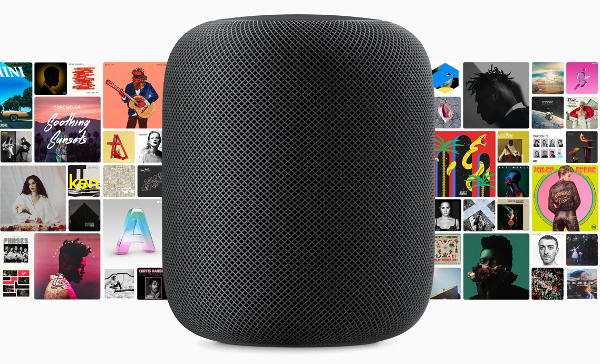Make Room for HomePod Page 2
Schiller: When we were designing HomePod, we knew it had to have best in class voice recognition to be able to hear someone from across the room, even while loud music is playing. We knew it had to understand voices, and hear someone say “Hey Siri,” even in challenging environments, like chatter around a dinner table or a TV playing in the background. This is a great example of the unique collaboration between our hardware and software teams at Apple. HomePod uses advanced machine learning techniques including deep neural networks (DNNs) optimized for the hardware to detect “Hey Siri” in challenging environments. The detection of “Hey Siri” happens on the device, so nothing is being sent to Apple until that trigger is detected and the Siri waveform lights up. At that time, the request is sent to Apple using an anonymous Siri ID, and of course that communication is all encrypted. We’re able to do this because we designed audio technology, advanced software, and Siri to work together as one system.
S&V: Let’s talk about smart-home integration. How does the HomePod facilitate voice control of HomeKit-enabled smart-home devices?
Schiller: The HomeKit ecosystem continues to grow rapidly and we’re working with all of the major brands across a number of categories, from smart lighting, door locks, and window shades to ceiling fans, garage doors, and cameras. From the very beginning, we engineered HomeKit to work great with Siri, so it understands all of your HomeKit accessories and how you want to control each of them. This means with HomePod, you can do many of the same things you’re used to doing with Siri on iPhone, like turn on the lights, set scenes when you say good night or say “I’m home.” And again, one of the biggest benefits of HomeKit, is that it’s secure and private.
S&V: The virtual assistant accounts for a lot of a smart speaker’s smarts. Apple recently made some advancements in Siri. What key changes or improvements were made in the context of HomePod?
Schiller: We think the intelligence of a smart speaker starts with music. For HomePod, it’s the amazing sound quality combined with Siri and music intelligence. That’s why we’ve worked hard to improve Siri’s understanding of music to deliver a more personalized experience. This tight integration of Siri and Apple Music allows HomePod to understand your music tastes and preferences, and lets you tune them by simply saying “I like this song” or “play more like this.” Using the latest advancements in machine learning and AI (artificial intelligence), we’re also able to play music based on a particular genre, mood or activity, or a combination of those, so HomePod knows what “dinner music” sounds like — for you — or what you mean when you want to relax.

S&V: At the launch event we were told Siri knows music really well and that Apple has been working hard to expand to “domains that matter most.” What sort of capabilities are we talking about and how might they differ from virtual assistants in other smart speakers?
Schiller: In addition to Siri’s deep knowledge of music, Siri understands over a dozen categories, Home as we’ve discussed, News, Alarms & Timers, Weather, Sports, Messages, and more. We also opened up SiriKit for HomePod, which allows you to use Siri to access your favorite messaging apps or add reminders, notes, and lists to the apps you use on your iPhone. And what’s important for all of this is the reason we call these “domains." Siri understands these topics deeply and understands what you’re looking for even though we all might ask for things in different ways. Siri understands meaning and intention, so it enables a more natural interaction.
S&V: Apple has some experience in speakers, having introduced the iPod Hi-Fi 11 years ago. How does that early experience figure into the HomePod launch? Any lessons learned?
Schiller: A lot has changed in 11 years. Look at what we’ve been doing with the speakers in iPhone, the quad-speaker system in iPad Pro that dynamically changes the stereo feel depending on how you’re holding it, and the technology designed for AirPods. We have an amazing audio team now and with HomePod they were asked to deliver amazing sound from a small, cylindrical design. They developed a beam-forming array made up of seven tweeters, each with its own individual amplifier. The tweeters use precision acoustic horns that guide the audio from within and then out along the bottom with tremendous directional control, and it has an Apple-designed 4-inch, upward facing woofer with a powerful motor to move a lot of air. And then there’s automatic bass equalization and dynamic software modeling so that as we turn the volume up, it maximizes its output potential.
S&V: How would you rank the importance of the following HomePod attributes: (1) audio performance/sound quality, (2) connectivity with other speakers in a whole-house/multiroom music system, (3) performance of the virtual assistant (Siri, in this case), and (4) the ability to connect with and control smart home devices?
Schiller: The most important attribute, and the one we map all of our products to, is user experience. Apple’s legendary ease of use and the ability to just plug it in and it works. In the case of HomePod, you just plug it in and talk to it. Siri’s intelligence helps you listen to music you love because it's designed from the start to understand music. We look at every product the same way, through a lens of what’s going to make this an incredible user experience. We try to create these products, like we did with AirPods, to solve a specific problem, and the same philosophy has gone into HomePod. You don’t need to understand how a speaker works or how to speak with Siri, you can simply place HomePod anywhere in your home and start listening to the music you love, and it will sound great.





























































